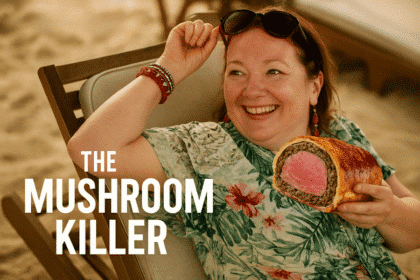Lauded water brand Liquid Death has announced that it will be “temporarily pausing” its international expansion after it moved production from Austria to the US last year.
Updated 10/2/25: Added comment from Liquid Death.
“Despite strong demand and brand awareness growth in our limited international rollout, we are temporarily pausing international efforts since we no longer have production capabilities outside of the US,” a spokeswoman for Liquid Death told UK-based F&B trade title The Grocer.
The spokeswoman added that Liquid Death was looking forward to “meeting the international demand in the future when our supply chain can support these efforts”.
Liquid Death confirmed to B&T that it will be halting its efforts in Australia.
“As of summer [Australian winter] 2024, Liquid Death completed its strategic shift from European production to 100 per cent U.S. manufacturing. This significantly expanded the company’s healthy beverage product lineup in flavoured sparkling water and iced teas, drove increased volume, and improved margins. Despite strong demand and brand awareness growth in our limited international rollout, we are temporarily pausing international efforts since we no longer have production capabilities outside of the U.S. We look forward to meeting the international demand in the future when our supply chain can support these efforts,” a spokesperson told B&T.
Liquid Death arrived in Australia in 7-Eleven stores at the start of last year. It arrived in Woolies stores around the country in September. The brand’s Still Water, Severed Lime sparkling water and Mango Chainsaw sparkling waters were all on offer, costing $4.50 each.
“We can’t wait to start murdering thirst in Woolworths, one of Australia’s largest supermarket chains,” said Mike Cessario, founder and CEO of Liquid Death said at the time.
“On the heels of our hypergrowth in the US, we entered the Australian market earlier this year. As longtime fans of Aussie comedy, like standup comedian Jim Jefferies and the dark comedy Mr Inbetween, we’ve loved bringing Liquid Death’s brand of comedy to a place with such a great sense of humour. Woolworths is the perfect partner to continue our momentum, and we’re thrilled to scale our healthy and infinitely recyclable beverage brand even further through these listings as we grow our footprint worldwide”.
Liquid Death has also used celebrities and left-field tactics to get its products into the minds of consumers. One of its first spots saw adult actress Cherie DeVille spruik the benefits of Liquid Death’s non-plastic packaging. More recent efforts saw it introduce the “Pit Diaper” with Depend to keep metal fans in the mosh, without having to go to the bathroom. It will also feature during today’s Super Bowl.
The news of its withdrawal might surprise some in the community. The brand was widely celebrated for its efforts in advertising and CEO Cessario spoke at last year’s Cannes Lions festival. However, its sales in the UK, at least, were reported to be around £2 million (AU$3.96 million), according Josh Clarricoats in Campaign.
Reaction from the marketing community has been mixed. Zoe Scaman, founder of Bodacious and chief strategy officer of 77X, as well as author of Mad Men. Furious Women said that attributing the pullback to failed marketing was misguided.
“To all the marketers gleefully jumping on this as validation of their skepticism: Do your damn research before celebrating. This isn’t the ‘I told you so’ moment you think it is,” she wrote.
“What we’re actually seeing is a temporary pause in international distribution while they optimise their supply chain (I.e. moving production from Austria to the U.S.). That’s it. It’s not some damning indictment of their brand strategy or proof that their marketing approach doesn’t translate globally.
“The rush to frame this as a marketing failure reveals more about industry cynicism than it does about Liquid Death’s actual performance or strategy.
“This wasn’t a brand issue—it was a supply chain one. And Liquid Death’s actions in the UK make it clear they were never seriously committed to the market. They did a one-off festival sponsorship (Download) but no sustained ad spend, no deep retail partnerships, no real investment. They dipped a toe in and pulled it out when the logistics didn’t work,” she added.
Mark Ritson, meanwhile, wrote back in July that that “the global marketing community was, once again, getting things completely out of proportion”.
“Sure, its water comes from the Alps. And there are those lovely aluminium cans. But no one talks about Liquid Death’s product. And that’s entirely the reason why the brand has become so prevalent across PowerPoint decks. It’s all about the ads. The attitude. The social. The events. And nothing else. That makes Liquid Death the perfect pin-up brand for a generation of marketers who define marketing as advertising and who spend their careers ignoring the remaining 90 per cent of our discipline’s hinterland,” he wrote.
Ben Kay, meanwhile, former international group creative director at TBWA\Media Arts Lab, posted on LinkedIn talking about the brand’s lack of affinity with UK audiences.
“It claims this is down to supply issues, but that demand is still high,” he wrote.
“But that’s not true, as ‘cans of Liquid Death were now being sold in Home Bargains for 39p each, and on a 3-for-£1 offer [AU$0.77 and AU$1.98, respectively].’ And ‘one source working in retail distribution told The Grocer “eyewatering amounts of excess stock” were currently being offered to discounters and off-price buyers in the UK and Europe.’
“So what’s the real story here? Does this brand only ‘work’ in the US? Are they missing a crucial one of the four Ps of marketing?
“It sounds like they have Place, with distribution in Tesco, Iceland, Ocado, Nisa and Co-op. Product is… well, it’s water, so you can’t really get that wrong. Price seems to have gone from £5.50 per 4x500ml [AU$10.89] pack in Tesco to the discounts mentioned above, so that covers most possibilities. And Promotion… I assume its spicy, provocative, break-the-internet ads get rolled out in the same social channels as they do in the US.”
Whether the brand recovers from this remains to be seen. Regardless, it remains an interesting case study.








